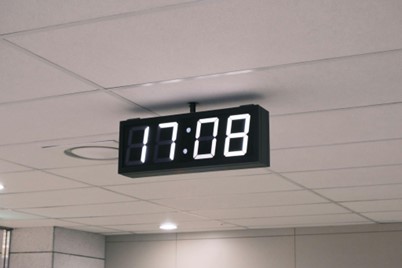Accurate and synchronized timekeeping is crucial for maintaining operational efficiency in any organization. While inexpensive standalone clocks might seem appealing due to their low upfront cost, they often fall short in delivering the reliability and synchronization required in professional settings. Investing in synchronized clock systems, such as those offered by Sapling, Novanex and Bodet, ensures consistent and precise timekeeping across your entire facility.
The Limitations of Standalone Clocks
Standalone clocks, especially those priced around $30, come with several drawbacks:
- Manual Adjustments: These clocks require individual setting and regular adjustments, especially during Daylight Saving Time changes or after power outages. This process is time-consuming and prone to inconsistencies.
- Time Drift: Over time, standalone clocks can drift unpredictably, leading to discrepancies that can cause confusion and disrupt synchronized activities.
- Maintenance Challenges: With each clock operating independently, ensuring uniformity in time display becomes a maintenance burden, increasing the likelihood of errors.
Advantages of Synchronized Clock Systems
Synchronized clock systems address these issues by providing a unified and accurate time display throughout your facility:
- Uniform Time Display: All clocks receive time data from a central source, ensuring everyone follows the same accurate time, which is crucial for coordination and efficiency.
- Automatic Adjustments: These systems automatically adjust for Daylight Saving Time and correct themselves after power outages, eliminating the need for manual intervention.
- Reduced Maintenance: With centralized control, maintenance efforts are minimized, and the risk of time discrepancies is significantly reduced.
Power over Ethernet (PoE) Clocks: A Modern Solution

PoE (Power over Ethernet) clocks, such as those from Novanex, offer a streamlined solution for synchronized timekeeping while simplifying installation and maintenance. These clocks are particularly beneficial for businesses, schools, hospitals, and other large facilities where accurate timekeeping and ease of management are essential.
Single Cable Installation
PoE technology allows both power and data to be transmitted through a single Ethernet cable. This eliminates the need for separate electrical wiring or power outlets near each clock, reducing installation complexity, labor costs, and potential electrical hazards. Since the clocks receive both power and network connectivity from the same cable, they can be installed in a variety of locations without requiring major infrastructure changes.
Energy Efficiency & Low Maintenance
By drawing power directly from the network, PoE clocks remove the need for batteries or standalone power adapters, reducing energy consumption and minimizing the hassle of battery replacements. This not only contributes to cost savings over time but also ensures consistent and uninterrupted operation without the risk of power loss due to dead batteries.
Seamless Scalability & Network Integration
PoE clocks easily integrate into existing network infrastructures, making them highly scalable for deployments across small and large facilities alike. They can be centrally managed and synchronized with network time servers, ensuring all clocks display the same accurate time across different locations. This is especially useful in environments where precise timekeeping is critical, such as schools for bell schedules, healthcare facilities for patient care coordination, or corporate offices for meeting and shift scheduling.
Sapling Synchronized Clocks: A Trusted Choice

Sapling offers a range of synchronized clock systems designed to meet the diverse needs of schools, healthcare facilities, corporate offices, and other organizations that require precise, reliable timekeeping. By leveraging advanced technology, Sapling ensures that its clocks remain accurate, easy to install, and simple to maintain.
Wireless Simplicity with Wi-Fi Connectivity
Sapling’s Wi-Fi Clock System is designed for hassle-free installation and seamless operation. Unlike traditional wired clock systems, these clocks connect to an existing Wi-Fi network and receive accurate time data from either an internet-based or in-house NTP (Network Time Protocol) server. This eliminates the need for dedicated wiring between clocks, reducing installation complexity and costs. Whether deployed in new buildings or retrofitted into existing infrastructure, Sapling’s Wi-Fi clocks provide a flexible, scalable solution for synchronized timekeeping.
Advanced Technology for Accuracy & Reliability
Sapling integrates cutting-edge technology to ensure its clocks maintain precision and consistency. Features such as automatic time updates, self-adjusting daylight savings time settings, and real-time synchronization with NTP servers help eliminate time drift and manual adjustments. This level of automation is particularly beneficial in environments where accurate timekeeping is crucial, such as hospitals for coordinating medical procedures, schools for managing class schedules, and businesses for optimizing productivity.
Versatile Solutions for Diverse Needs
Beyond Wi-Fi clocks, Telnet Networks offers a variety of synchronized clock systems, including wired, wireless RF, and PoE options, allowing organizations to choose the best solution for their specific environment. With a commitment to innovation and reliability, Sapling provides high-quality timekeeping solutions that enhance operational efficiency, improve punctuality, and ensure seamless synchronization across facilities.
While inexpensive standalone clocks might offer short-term savings, they often lead to increased maintenance and time discrepancies. Investing in synchronized clock systems, such as those from Sapling and Novanex, ensures accurate, reliable, and maintenance-free timekeeping, ultimately enhancing operational efficiency and coordination across your facility and organization.






